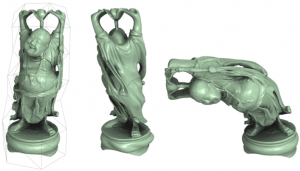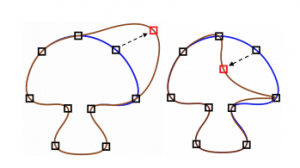 “Computer graphics is math made visible,” said Scott Schaefer, Computer Science and Engineering professor and associate department head at Texas A&M University. “I can’t draw a straight line, but I can make beautiful pictures with math.”
“Computer graphics is math made visible,” said Scott Schaefer, Computer Science and Engineering professor and associate department head at Texas A&M University. “I can’t draw a straight line, but I can make beautiful pictures with math.”
The Rice University alumnus (Ph.D. ’06) said his fascination with graphics began with computer games when he was an undergraduate student.
“Once upon a time, like so many undergraduate computer science majors, I wanted to build computer games. At the time, the game industry was brutal to work for –with long hours, low pay, and immense competition for jobs– and I realized that this was not going to be a viable career path. However, my interest in computer graphics (the visual aspect of computer games) remained,” said Schaefer.
For Schaefer, one of the most appealing aspects of computer graphics was the tangible proof of his work.
He said, “I could show the results of my work to people, and they could be impressed and admire what I had done. Other fields of computer science lack this accessibility. I can code up self-balancing trees or interesting probabilistic data structures, but showing my Mom that I can insert/delete/find elements quickly (expected Log(n) time) just doesn’t impress her. On the other hand, she can easily appreciate the results of my work in graphics.”
Another aspect of computer graphics that appeals to Schaefer is the mathematics. He double-majored in computer science and math at Trinity University and found computer graphics to be the perfect connection of the two fields.
“In computer graphics, I found applications of the abstract mathematical topics I was learning about in my math classes. Plus, much of computer graphics is really applied geometry. I think of myself as an applied geometer, which is perfect for my area of research: geometric modeling,” he said.
One of his recent geometric modeling projects was a collaborative research effort with Adobe, known for creative image management solutions like Photoshop and Illustrator.
Schaefer said the goal was to build curves that users could intuitively control. However, determining what intuitive meant was no easy task.
“Adobe had the idea (backed up by another piece of research) that maximal curvature points where the curve bends the fastest were perceived as features. Therefore, we’d like to be able to control where these maximal curvature points exist on the curve and make sure that they occur nowhere else. Unfortunately, curvature is a very nonlinear quantity and is very difficult to control. In addition, they wanted curves that were curvature continuous,” said Schaefer.
That is where his passion for geometry and math came into play. Schaefer said the team devised a representation composed of piecewise quadratic curves, due to their simple curvature properties. Then they demonstrated how to connect these curves together into a curvature continuous almost everywhere representation.
“We then developed an efficient optimization for finding these curves. The result was a type of interpolatory curve that doesn’t suffer from classical problems that interpolatory curves typically have, which has limited their use for over forty years,” explained Schaefer.
Photo caption: Figure 10, from Schaefer’s κ-Curves paper showing how the curves move when the user modifies them.
“In the end, Adobe was quite pleased with the result. They added the curves to Adobe Illustrator, their vector graphics editing tool, calling it the “curvature tool.” This tool competes directly with Adobe’s pen tool that has been in existence for decades and has a well-trained artist base.”
The new feature was quickly adopted by Adobe Illustrator’s users. Based on Adobe’s own usage statistics for the first six months after the curvature tool was released, artists using desktop platforms chose the new tool over the pen tool thirty-five percent of the time.
Schaefer said, “Adobe’s statistics for touch screen devices, which tend to have more novice users that have not yet become experts with the pen tool, showed the curvature tool was used sixty-six percent of the time. Such rapid adoption of a new tool was very encouraging, and Adobe decided to add the curvature tool to its latest release of Adobe Photoshop as well. So, if you’re interested, you can try it out yourself.”
Schaefer’s original goal upon entering college wasn’t to pursue a Ph.D. Though he intended to pursue an industry career after college, he was drawn to academia instead. He said, “I wanted to do things that no one else had done before. That’s the end goal of a Ph.D., to provide a significant expansion of knowledge in a focused area. So I applied to a lot of CS Ph.D. programs across the country and also interviewed for industry jobs.”
Offers came in from each employer that interviewed Schaefer, but the jobs didn’t excite him. “No one would pay me to do what I really wanted to do,” he said. “At Rice, I’d finally have a chance to indulge my passion.
At the end of his Ph.D. program at Rice, Schaefer again had the opportunity to work in industry, and once again he chose academia.
“As a CS professor, I have the freedom to work on problems that I find interesting. It turns out that I like working on projects that are useful in industry, but I don’t have to. An academic job is what you make of it. If I am unhappy with my job or what I am working on, it’s my own fault. Of course you still need to be successful in the choices that you make, but the freedom of choice is very appealing.”
Schaefer said the opportunity to work closely with students was another reason he chose academia over industry. He enjoys interacting with them, watching discovery as it is revealed in their faces when they learn something for the first time. And he both encourages and joins in their passion for a topic.
“I love showing students something surprising,” he said. “For example, I do a lecture in my computer graphics class on color, which touches quite a bit on the human visual system and perception. I ask the students what color is, and I inevitably get back responses about the wavelength of light.”
“Then I show them a false color image that I have them stare at. I click a button and that image changes to one with blue skies, green grass etc… I tell the students to move their eyes when they are ready. When they do so, the picture changes instantly to a black and white image. There never was a color image with blue skies and green grass. Color was never there at all, yet the students perceived color in its absence.
“The point is to emphasize the perceptual nature of what we are doing, but the audible surprise from the class — and the students that come and tell me the next week that they showed it to all of their friends– is what teaching is all about.”
Scott Schaefer completed his M.S. in Computer Science in 2003 and his Ph.D. in 2006. His adviser was Joe Warren.

